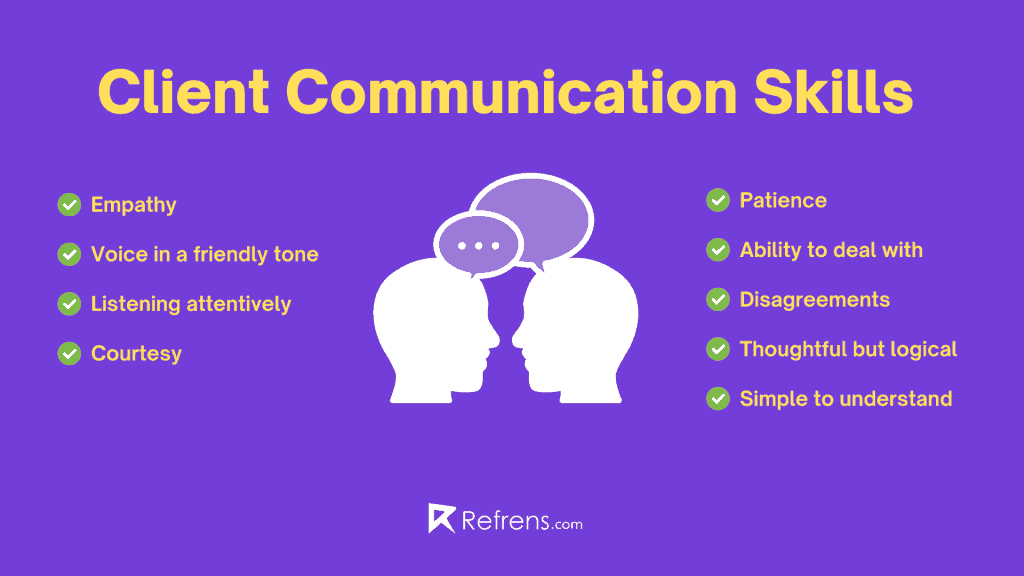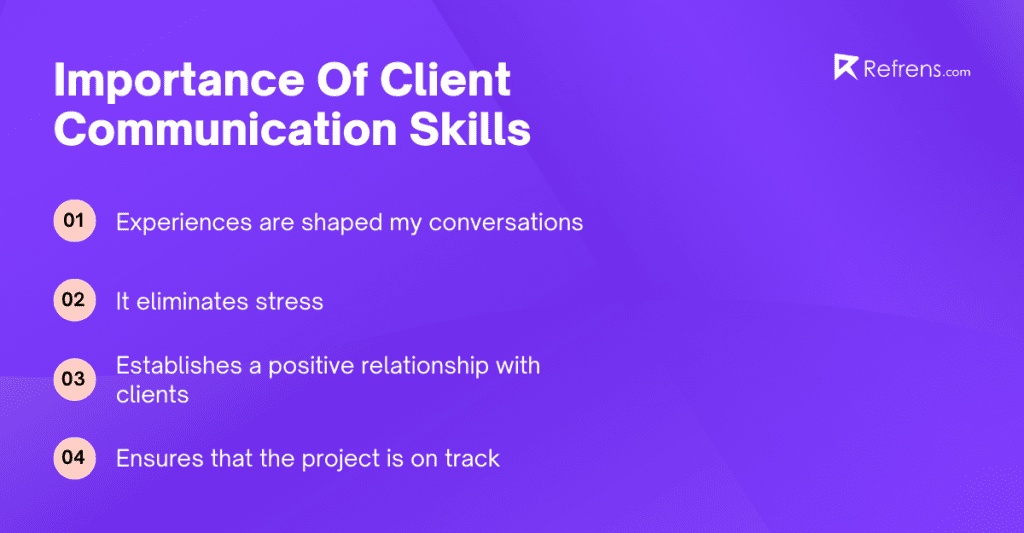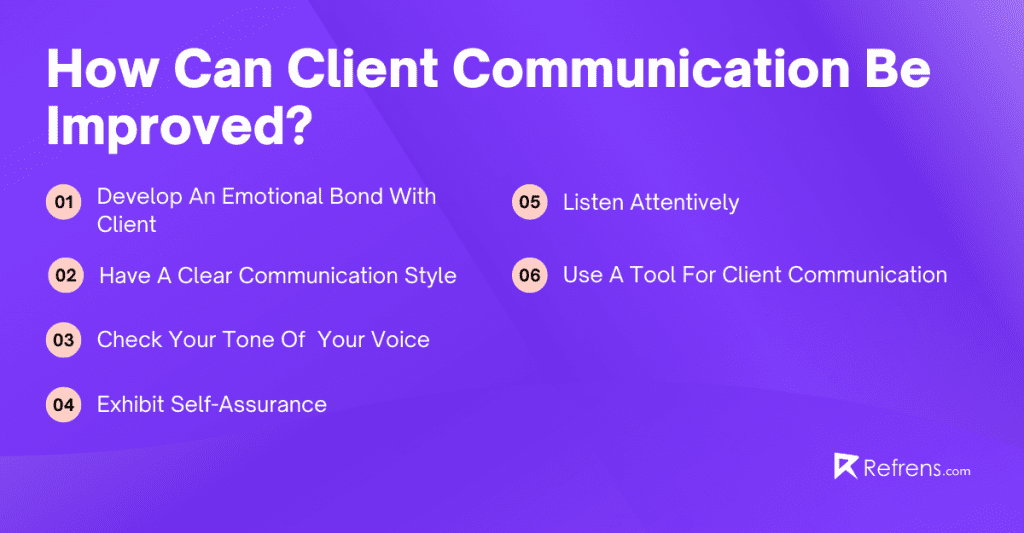Do you have a good client communication system in place?
Even if your organization is excellent at acquiring and converting quality leads, this does not always transfer into the capacity to form strong, long-term relationships.
Moreover, without them, you won’t be able to completely realize your market potential.
As a result, an increasing number of businesses are implementing strategies aimed at establishing effective client communication.
To be effective, this type of activity must be based on a well-structured strategy, which begins with the creation of a buyer persona.
A buyer persona is a fictional version of a target consumer based on market research. Buyer personas depict your ideal customers, including how they spend their days, the problems they face, and the decisions they make.
So, how can you properly interact with your client?
The solution is to establish effective client communication practices. Many of them might already be in place, but if you want to take your client communication to the next level, it’s recommended to include the following components mentioned below into your freelance skills.
Let’s start with some basic inquiries that are essential for efficient client communication.
What Do You Mean When You Say “Client Communication”?
Client communication refers to the reporting, conversations, and information transfer that occurs between a service provider (business) and a service seeker (client) in the course of a project’s completion.
Effective client communication is essential for freelancers for maintaining strong business relationships and ensuring project quality meets expectations.
If you work in a client-facing position, your communication abilities can make or destroy your career.
As a result, you must consistently improve your skills and develop a robust client communication plan.
Client Communication Skills
Client communication skills are a combination of verbal, interpersonal, and emotional talents that allow you to have clear, meaningful, and emotionally aware talks with clients.
It’s no surprise that client conversations frequently go bad, leaving plenty of possibilities for misunderstandings.
Moreover, a skilled communicator understands how to navigate communications with little to no room for error.
The following are the characteristics of a skilled communicator that can be identified in their conversations:

Furthermore, experience is the best teacher when it comes to client communication skills. When it comes to building exceptional client communication skills, your soft skills and overall communication abilities go a long way.
What Is the Importance of Effective Client Communication?

- Experiences Are Shaped By Conversations
A meaningful chat with the customer can help you strengthen business ties, just like a good conversation with a friend can help you relieve stress. Let’s start by establishing the value of customer communication by examining the perks available.
For example, you’ll be disappointed if you order Latte Coffee at your favorite cafe and have it served with espresso. This is because your expectations were not met.
It’s the same thing when it comes to serving clients. When there is effective client communication, the client knows what to anticipate and when to expect it. Unlike the Espresso, they’ll feel like they’re not getting exactly what they asked for.
According to a McKinsey survey, 70% of customers relate their satisfaction to how they are treated. That is when expectations exceed results are more enjoyable encounters and there is a sense of professionalism.
- Eliminate Stress
It’s not surprising that 85 percent of people find having to repeat information while working with other companies unpleasant. This occurs in modern projects when stress accumulates. Thus, effective client communication cuts through the stress and gets right to the point.
Additionally, the instructions are easier to process for the executing team leading to reduced workplace stress.
Check out how to deal with real freelance burnout.
- Establishes A Positive Relationship With The Client
Because they aim to establish a relationship, successful communicators always make their listeners feel good about themselves. Even challenging situations can be managed in the presence of a solid connection without losing the client’s trust, boosting loyalty.
According to a survey, loyal consumers are four times more likely to recommend your company to others and five times more likely to buy again.
- Ensures That The Project Is On Track
Poor client communication skills frequently cause misalignment of projects. Tasks are delayed, and deadlines are missed.
When communication is on point, the project moves along at the proper rate, even if there are setbacks.
You can communicate with each other even more effectively when choosing the right unified communications features. In such a way, you can demonstrate your best communication skills and develop meaningful relationships faster.
How Can Client Communication Be Improved?

1. Develop An Emotional Bond With Your Client
Humans are emotional creatures, even if professional places are not.
It’s vital to connect with the customer on an emotional level to better interpret them. It doesn’t mean you have to help them with their anger issues or engage in intellectual discussions with them. Rather, it implies being conscious of sentimental overtones.
The majority of people learn how to connect emotionally on the job. However, knowing what it comprises can assist you in developing it properly.
It is made up of four main components:
- Self-awareness– Its the ability to recognize emotional remarks in a conversation by understanding how you react to them.
- Self-control — Staying in tune with your ideas during a conversation so that emotional upheavals don’t take over.
- When you sit down with the customer, you should have a general awareness of the social setting, obligations, etiquette, and decorum.
- Empathy – The ability to understand and respond to the client’s point of view as if it were your own.
Why Does It Matter?
As it allows you to pick up on the deeper context of the communication, emotional connection is a key component of managing client relationships.
Further, it teaches you how to deal with emotional outbursts and how to perceive communication in a more empathetic manner. This can hence, help you maintain a healthy discussion and friendship.
2. Maintain A Concise, Clear, And Context-driven Communication Style
The fundamental skill of good communication is expressing yourself in a way that is simple to understand.
But what exactly is this “easy-to-digest” method?
- It’s said in simple language with carefully picked words.
- It uses precisely the perfect number of words to describe the speaker’s point of view.
- It is believed to consider the listener’s authority, state, and relevancy.
These statements are translated as follows in our case:
- Important details, such as progress, deadlines, costing, and so on, should be communicated in clear language. Terms like “nearly,” “maybe,” and “many” should be avoided because they cause misunderstanding.
- Keep your customer conversations focused on the agenda. Hold topics that are relevant right now, and schedule when you’ll talk about what. Trying to cram too much information into a single conversation can be counterproductive.
- Be conscious of how the client will obtain specific information. Pay attention to the context of the agenda at hand, as well as the audience to whom it is being delivered.
Why Does It Matter?
To avoid confusion during the project’s execution, maintain client communication simple, concise, and context-driven. It allows you to maintain a healthy level of client expectations while avoiding overcommitment or false affirmations. To achieve this, you also need to define what communication solutions your clients prefer; some of them like to use local phone service, while others prefer messaging apps. By finding a clear communication style and the right platforms, you can build strong communication with clients.
Moreover, in a large project, it’s easy to lose track of context, and simple tasks can become complicated. So here you can consider using approval software tools that helps to keep track of feedback and revisions, ensuring clear communication.
As a result, going the extra mile to keep context is always a good idea. To ensure that you maintain clear communication define what channel they prefer. To connect with some of them you should send an SMS over Wi-Fi, while others are much more comfortable having a conversation via messaging apps.
3. Keep An Eye On The Tone Of Your Voice
The majority of the time, “how” things are conveyed is more significant than “what.”
You’ll understand why tone and voice are so crucial if you’ve ever completed a client communication training course. This holds true for both written and oral communication. Engaging with corporate training solutions will help professionals master the nuances of tone, ensuring that their communication aligns with the intended message.
As a result, even if you never meant to be loose, harsh, rigid, or hesitant, your tone may reveal it.
Moreover, communicate with good intentions most of the time, yet the tone completely changes the impact. And when it comes to intentions vs impact, impact always wins.
4. Exhibit Self-Assurance
When the tone is professional, clients are the happiest. If you’re not sure what a professional tone is, consider the following:
- Maintain a respectful and sincere demeanor.
- Use terminology that is neutral and non-discriminatory.
- Always keep in mind “how this benefits the client.”
- Avoid employing a tone that is judgmental.
Why Does It Matter?
You may ensure that the message you’re trying to communicate with the client is received correctly by utilizing the appropriate tone.
It’s one of the most important client communication abilities for maintaining a smooth discussion flow. It also aids in the formation of a strong client relationship and the development of a rapport with the client.
Hence, the correct tone can sometimes make difficult topics easier to swallow while maintaining mutual respect with the customer.
5. Emphasis Appropriately
Certain ideas, it’s acceptable to believe, require more attention than others. If your costs are higher than the competition’s, you may want to emphasize the benefits of your product while downplaying the costs.
When you wish to emphasize a point that MATTERS MORE, use emphasis.
You can always delegate the notion that demands less attention because it isn’t the conversation’s main goal, and simply spend more time speaking in general.
That is how you may effectively communicate with the client.
In a client meeting, techniques for emphasizing are:
- Devote more time to issues that require greater attention, and bring them up in the conversation as soon as possible.
- When presenting important concepts, use a concerned tone,
- Use formatting signals in written communication to highlight concepts that require quick attention.
- Important concepts should be communicated in an active voice.
- Use color clues or project tags to assign importance to ideas being presented to the customer
Why Does It Matter?
Having a clear separation of what belongs on the top, middle, and bottom of the page can help you maintain your message in the order.
Client communications are becoming increasingly complicated. You may never be able to end a meeting if all of the ideas are given the same priority and time. As a result, being aware of the wider picture will allow you to have relevant interactions without sacrificing quality.
6. Listen Attentively
The most underestimated client communication skill is listening.
Listeners who pay attention become better communicators.
Moreover, they can accurately and thoroughly grasp the client’s instructions while making a few interpretation errors. You’ll be able to ask the right questions, clarify doubts quickly, and verify you’ve understood the client correctly if you’re an active listener.
Hence, the following tips will assist you in practicing active listening:
- Practice focused listening to help you absorb information without being distracted from the topic.
- To avoid the conversation sounding like a monologue, use acknowledgments such as verbal nods and affirmative remarks at regular intervals.
- Engage the speaker with follow-up questions to elicit additional information.
- When you’re not sure about something, pause and rephrase the speaker.
Why Does It Matter?
Active listening helps you avoid misunderstandings, eliminate back-and-forth with clients, and avoid delays caused by ineffective information absorption.
With sharp active listening skills, you may drastically minimize the time it takes to finish a client project and keep your team productive.
7. Make Use Of Virtual Tools and Software For Client Communication
Most client encounters will be held online as remote work becomes more common and workplaces become more mobile. So, consider using a mobile carrier lookup to prevent fraud and streamline communication.
It’s no surprise that 55 percent of worldwide firms provide remote work options, and 90 percent of remote workers enthusiastically suggest it to their peers.
The requirement for a dependable Client Communication Tool becomes clear when considering the virtual nature of communication.
Moreover, when the majority of the team members, including the client, are geographically dispersed, successful communication requires more than phone calls and video conferences.
As a result, a technology that can integrate team members, clients, and team managers into a single communication platform is required. For virtual and remote communications with clients and staff, cloud-based contact center integration and PBX-related solutions are some of the available options that combine multiple services.
Thus, the Client Communication system becomes an important element of the communication process, and it encompasses a wide range of other tasks, including Client Reporting Management, Client Collaboration, and Productivity Reporting.
Why Does It Matter?
Communication tools like NuovoTeam Push-to-Talk App and Troop Messenger are inevitably replaced by project management software, which forms the backbone of highly productive teams
As a result, these technologies have risen to the top of the priority list for effectively managing teams and clients in professional settings.
If you’re in charge of a remote team or want to improve in-office client communication, a software application can help you achieve the flow and efficiency you desire. For example, using software to create a digital brochure can save you time and money by providing all the necessary information to clients. This helps clients resolve issues quickly and without the need for additional assistance. Similarly, this information can also help your team to better serve clients, resulting in improved customer satisfaction and a better overall experience for everyone involved.
Conclusion
Are you ready to make client communication your strength?
Follow the recommendations in this article for efficient client communication and put what you’ve learned to use at work.
Furthermore, if you are just starting as a freelancer and are having trouble locating clients, check out the Refrens platform, which will assist you in finding clients who meet your needs.
FAQs
What are the basic communication skills?
Basic communication skills refer to the fundamental abilities that allow individuals to exchange information, thoughts, ideas, and feelings effectively with others. These skills are essential for building relationships, conveying ideas, and understanding others in personal, social, and professional settings.
What are good communication skills for?
Good communication skills are essential for success in personal and professional life. They play a vital role in building and maintaining relationships, understanding others, and achieving common goals.
What are the barriers of communication skills?
There are many barriers that can hinder effective communication skills. Some common barriers include: language barriers, physical barriers, emotional barriers, cultural barriers, perception barriers, attitudinal barriers, cognitive barriers, environmental barriers, technological barriers.
Types of communication skills
There are many types of communication skills, including: Verbal, Nonverbal, Written, Listening, Presentation, Interpersonal, Negotiation, Conflict resolution, Emotional Intelligence
Read more :



















